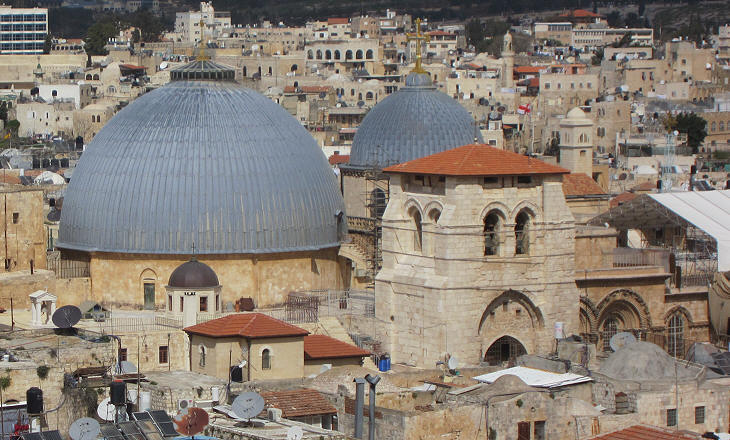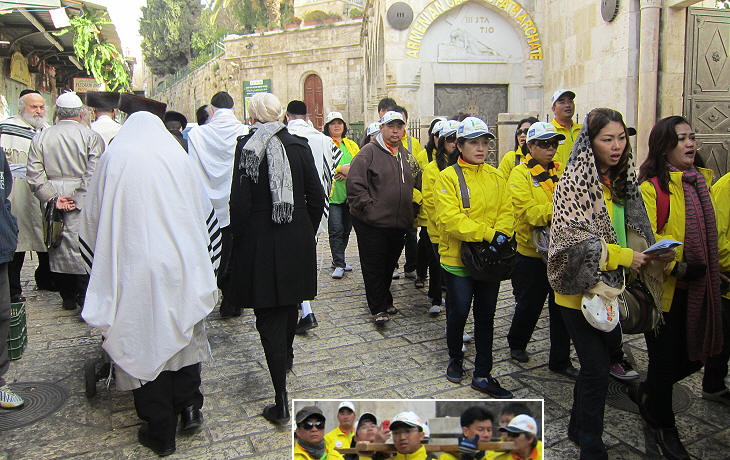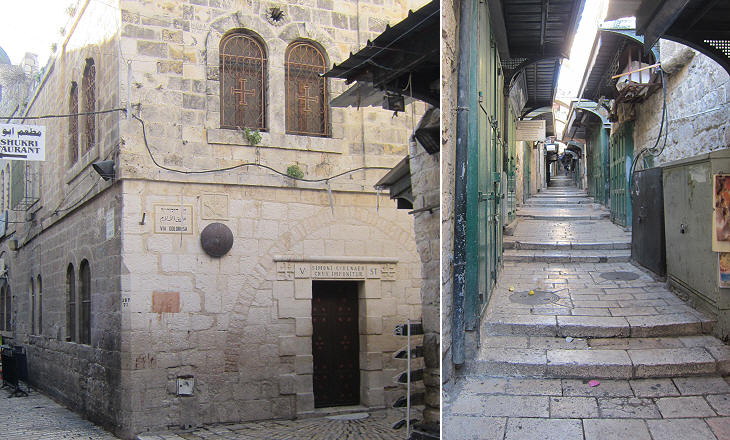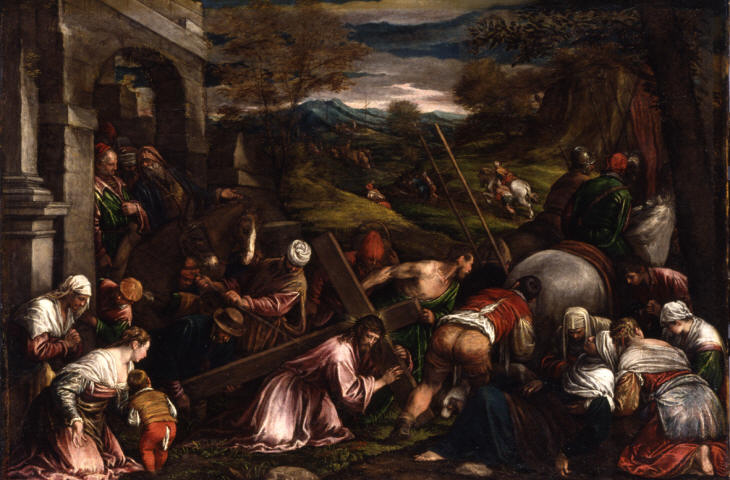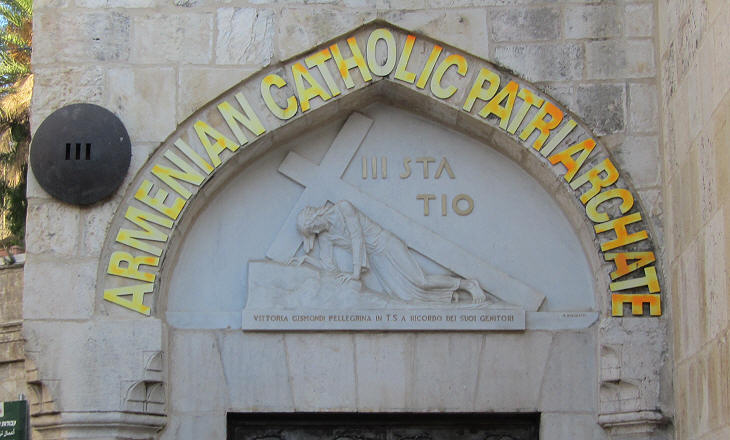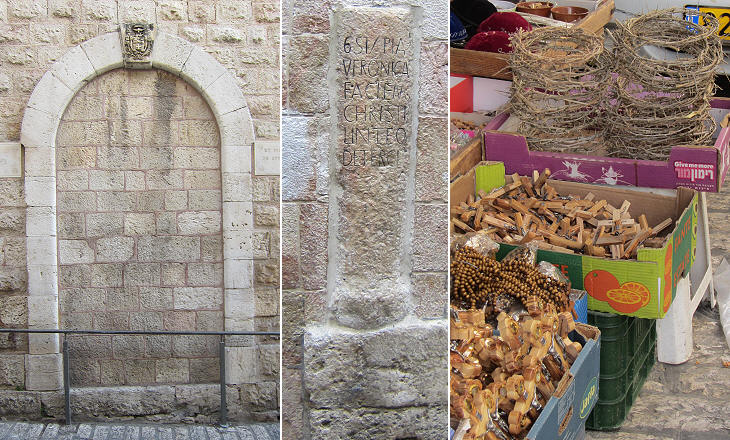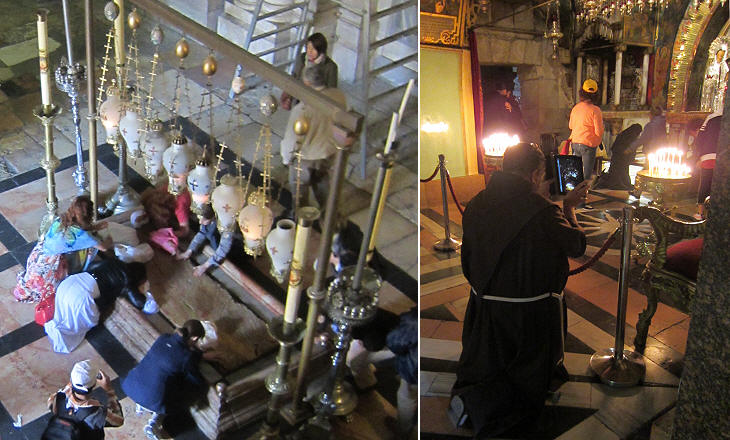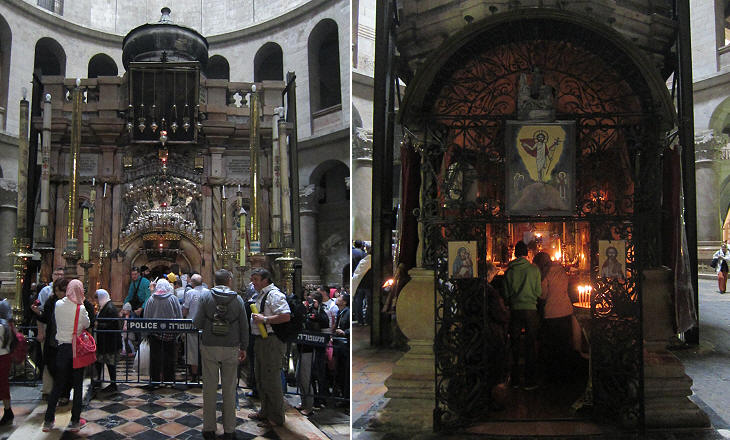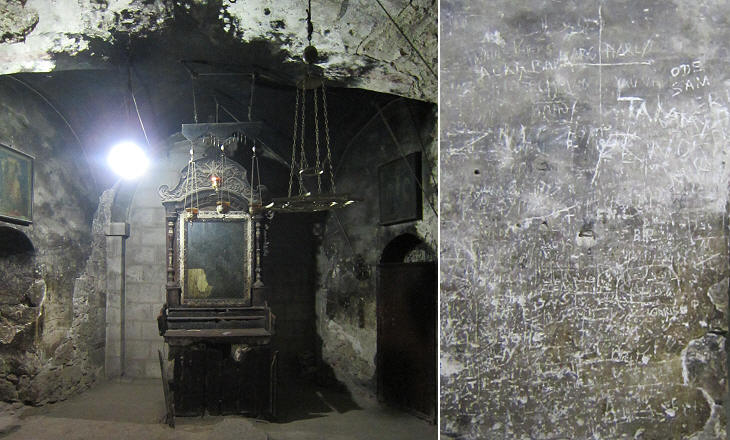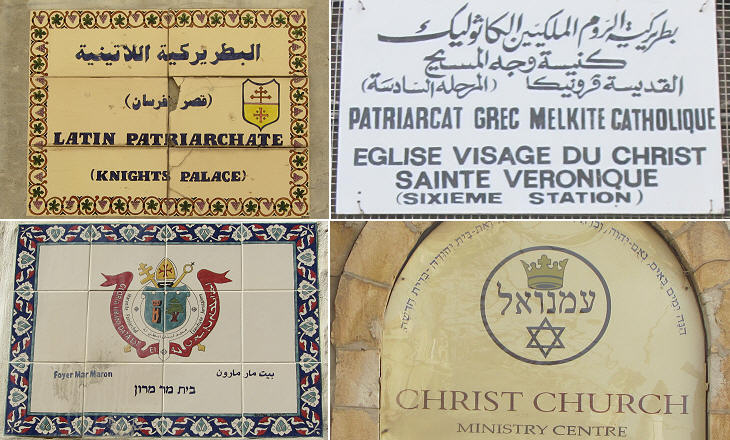  What's New! Detailed Sitemap All images © by Roberto Piperno, owner of the domain. Write to romapip@quipo.it. Text edited by Rosamie Moore. Page added in May 2013. |
 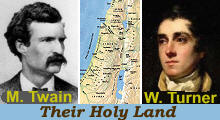 - Jerusalem - Holy Sepulchre and Via Dolorosa - Jerusalem - Holy Sepulchre and Via Dolorosa
In the morning the dragoman (interpreter) went to show my firman (permit to travel) to the Aga (governor) of the city and obtained for me and my servant a permit to enter the Holy Sepulchre without being subject to molestation or extortion. William Turner - Journal of a Tour in the Levant - 1820 One naturally goes first to the Holy Sepulchre. It is right in the city, near the western gate; it and the place of the Crucifixion, and, in fact, every other place intimately connected with that tremendous event, are ingeniously massed together and covered by one roof - the dome of the Church of the Holy Sepulchre. Mark Twain - The Innocents Abroad - 1869
The church of the Holy Sepulchre is a large building including within its walls the Tomb and the supposed Mount Calvary with all the space between. (..) Although I forbear, from a consciousness of the difficulty of the task, to enter on any discussion as to the topography of Jerusalem and the real site of the holy places, I cannot but notice the improbable position ascribed here to the Holy Sepulchre. W. Turner The sites of the Crucifixion and of the nearby Sepulchre were established in the IVth century and a map of the VIth century (it opens in a separate page - number 3) shows a large basilica which included Mount Calvary and the Holy Sepulchre.
Every day I passed in Jerusalem more clearly proved to me the truth of the observation made by Hume that the more affinity there is between theological parties the greater commonly is their animosity. (..) During my stay in Jerusalem I frequently called on a Greek bishop and sat smoking with him for an hour asking questions. I did the same to some Armenian and Coptic priests. Next to these people's hatred of each other, their most frequent subject of conversation was their entire confidence that the time was near at hand when all mankind would be of one religion and this religion each different priest assured me would most undoubtedly be his own. W. Turner Douglas Hume (1711-76), a Scottish philosopher, argued that monotheism arises from competition between religions as believers seek to distinguish their deities as superior to all rivals (The Natural History of Religions). The remark made by Turner is even truer today. The secular visitor to Jerusalem is struck by the total lack of interfaith dialogue. Believers are totally immersed in their own creed which eventually they expect will prevail.
I followed the course of the Via Dolorosa, the road by which our Saviour is supposed to have borne his Cross to the place of Crucifixion which begins about the middle of the street running west in which stands the Roman Catholick convent. At the end of this street the Via Dolorosa turns into a short street which runs south and then again into another long one which continues it to the west. W. Turner The course of the Sorrowful Way was established in the XVIIIth century by the Franciscans of Jerusalem. Their order and in particular its Capuchin branch used to build its churches on elevated ground and have them preceded by Stations of the Cross. In 1731 Pope Clement XII issued a bull to regulate the Stations of the Cross: he established that they were fourteen and that their design should be approved by the Franciscans (see S. Bonaventura al Palatino in Rome).
Turner, similar to most European travellers, was struck by the differences between Via Dolorosa and the many "Way to Calvary" he had seen in paintings and prints. Via Dolorosa starts by sloping down and only its last section goes up. It is very short. It is entirely inside the walls. In 1883 General Charles Gordon (aka Gordon of Khartoum) came to the conclusion that the Crucifixion site and the Holy Sepulchre were located half a mile north of Damascus Gate and most Anglican pilgrims go there rather than to the Holy Sepulchre.
The first thing that was pointed out to me was the spot on which Jesus first fell while bearing his Cross. It is marked by a small column lying broken on the ground and is at a short distance from the Roman Catholick convent in the same street. Near this a little further on is shewn the place at which he advised the women to weep for their own woes, not for his. The place of the second fall is shewn in the small street that runs south and is also marked by a fallen column. A little way down a third street which turns again to the west is an arch stretching over the street on the site of which - said my conductor - stood a house close to which (..) leaned a woman named Maria the Sinner who, as Jesus passed with the Cross, called out "Here comes he who will I hope make my fortune". Jesus replied "I shall never make thy fortune". On hearing which answer she immediately broke a drum which she had been wantonly beating and became one of his followers. Where these people picked up this story I am at a loss to conceive. (..) These places are so firmly believed here to have been the scenes of the events above cited that it would have been impolitick in me to express the doubts which were naturally excited in me by the inconsistency of the accounts. (..) But there would be no end of my journal if I were to descant on all the absurdities that are related to me here. W. Turner
"On these stones that are crumbling away," the guide said, "the Saviour sat and rested before taking up the cross. This is the beginning of the Sorrowful Way, or the Way of Grief." The party took note of the sacred spot, and moved on. We passed under the "Ecce Homo Arch," and saw the very window from which Pilate's wife warned her husband to have nothing to do with the persecution of the Just Man. (..) We crossed a street, and came presently to the former residence of St. Veronica. (..) We had heard so much of St. Veronica, and seen her picture by so many masters, that it was like meeting an old friend unexpectedly to come upon her ancient home in Jerusalem. We knew her, because we saw her handkerchief in a cathedral in Paris, in another in Spain, and in two others in Italy. In the Milan cathedral it costs five francs to see it, and at St. Peter's, at Rome, it is almost impossible to see it at any price. M. Twain We found crowds of pilgrims (..) at which were selling beads, crucifixes, pictures of the Virgin. W. Turner
Immediately on entering the church of the Sepulchre is seen in front of the door the spot where the body of our Saviour is said to have been anointed before interment. This has been covered by the Greeks with a handsome stone measuring nine feet by four feet one inch. The stone which covered it formerly said to have been the original one has been taken away by the Greeks. It belonged to the King of France. W. Turner Before you is a marble slab, which covers the Stone of Unction, whereon the Saviour's body was laid to prepare it for burial. It was found necessary to conceal the real stone in this way in order to save it from destruction. Pilgrims were too much given to chipping off pieces of it to carry home. M. Twain The hole said to be that of the Cross on the summit of Calvary is 110 feet from the dome south east. The holes of the crosses of the two thieves were at eleven feet four inches to the right and left of that of the Cross of Christ, but were obliterated by the late fire. The hole of the Cross of Christ is twenty two inches deep. (..) The Greeks I know not why, except that their hatred of the Roman Catholicks induced them to differ wantonly from them, have made another hole about two feet north of the supposed original one which all the Greek and Armenian pilgrims kiss and throw money into it. I had been told that all who did this received absolution for all their sins past, present and future, but a Greek priest whom I saw swinging incense on the spot, assured me that this was not true, but that they worship there because the Greeks and Armenians believe this to be the hole of the true Cross. (..) He added that the jealousy of the Roman Catholicks perpetually prompted them to misrepresent the Greek religion. The bitterness of feeling which these sect cherish towards each other is peculiarly disgusting on the spot where it would be supposed Christians would most earnestly study to forget their differences. W. Turner When one stands where the Saviour was crucified, he finds it all he can do to keep it strictly before his mind that Christ was not crucified in a Catholic Church. He must remind himself every now and then that the great event transpired in the open air, and not in a gloomy, candle-lighted cell in a little corner of a vast church, up-stairs - a small cell all bejeweled and bespangled with flashy ornamentation, in execrable taste. M. Twain
The old Sepulchre was burnt on the 12th of October 1808. The fire began at three in the morning and burnt till nine having destroyed the Armenian chapel where it began, the great dome, the Greek chapel, the cells of the Franciscans and the chapel of the Virgin and destroyed many of the fine columns and of the mosaick work contributed by Helena. The Sepulchre itself was not touched, but the Catholicks say that in the confusion the Greeks pulled down the chapel built over it that they might rebuild it and call it their own. The Roman Catholick monks believe that the Greeks and Armenians purposely set fire to the building. (..) The Roman Catholicks have apartments and a refectory behind the Sepulchre as indeed formerly the whole was theirs, but the Greeks, Armenians, Copts and Syrians, making interest with the Turks by paying them immense sums, have turned the Roman Catholicks out of many of the holy places. W. Turner All sects of Christians (except Protestants,) have chapels under the roof of the Church of the Holy Sepulchre, and each must keep to itself and not venture upon another's ground. It has been proven conclusively that they can not worship together around the grave of the Saviour of the World in peace. (..) One is grave and thoughtful when he stands in the little Tomb of the Saviour - he could not well be otherwise in such a place - but he has not the slightest possible belief that ever the Lord lay there, and so the interest he feels in the spot is very, very greatly marred by that reflection. M. Twain
The Syrian church is small and very shabby containing nothing but a very plain altar. There is a small door in the side stooping under which one enters a natural cave. At the bottom of this (..) is a tomb of which the stones still remain called by the Catholicks the tomb of Nicodemus. (..) I was surprised that the monks did not rather give the name of the Holy Sepulchre to the supposed tomb of Nicodemus which, however exceptionable in point of locality, is at least cut in the rock. W. Turner That of the Syrians is the humblest of them all. It is nothing but a dismal cavern, roughly hewn in the living rock of the Hill of Calvary. In one side of it two ancient tombs are hewn, which are claimed to be those in which Nicodemus and Joseph of Aramathea were buried. M. Twain
(The new church) is neither so large, nor so splendid as the ancient one which had many very large and well proportioned columns of marble. (..) The Armenians obtained from the Roman Catholicks many holy places some years ago by professing themselves Catholicks, but as soon as they had them in their possession, they changed to their former religion. W. Turner Then we went down into a cavern which cavilers (those who raise annoying petty objections) say was once a cistern. It is a chapel, now, however - the Chapel of St. Helena. It is fifty-one feet long by forty-three wide. In it is a marble chair which Helena used to sit in while she superintended her workmen when they were digging and delving for the True Cross. M. Twain
Under Mount Calvary to which one descends by forty one stairs is the spot where Helena found as it is thought the true Cross. (..) At first the monks assured me they could not find the Cross, but Helena prayed and instantly the earth trembled in the spot where the Cross was concealed. W. Turner We descended twelve steps into a large roughly - shaped grotto, carved wholly out of the living rock. Helena blasted it out when she was searching for the true Cross. She had a laborious piece of work, here, but it was richly rewarded. Out of this place she got the crown of thorns, the nails of the cross, the true Cross itself, and the cross of the penitent thief. When she thought she had found every thing and was about to stop, she was told in a dream to continue a day longer. It was very fortunate. She did so, and found the cross of the other thief. (..) The monks call this apartment the "Chapel of the Invention of the Cross" - a name which is unfortunate, because it leads the ignorant to imagine that a tacit acknowledgment is thus made that the tradition that Helena found the true Cross here is a fiction - an invention. It is a happiness to know, however, that intelligent people do not doubt the story in any of its particulars. M. Twain
Turner and Twain were struck by the presence of so many Christian groups in Jerusalem. The more they would be today because the number of churches with an office in Jerusalem has grown considerably. The image used as background for this page shows a decorated tile in the Chapel of the Invention of the Cross. See these other pages on Jerusalem
Move to: Introductory Page Nimrod Castle Banias (Caesarea Philippi) Acre (Akko) Turner's excursion to Kaifah (Haifa) Tiberias Holy sites in Galilee Nazareth Jaffa A Glimpse of Tel Aviv  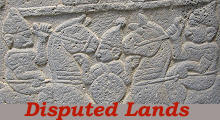 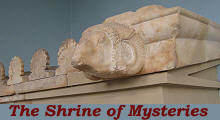  |
